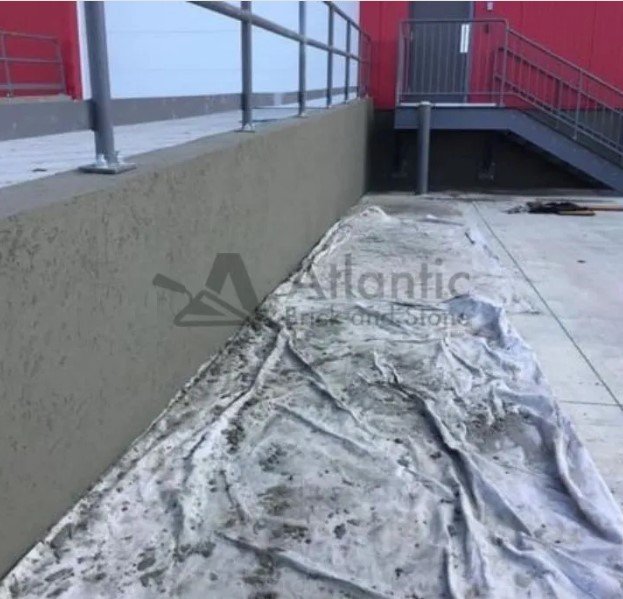Does your home need some TLC to boost its curb appeal and weather resistance? Get the full picture on parging – a simple solution for foundation protection. This complete guide to Parging takes you through why, when, and how experts approach the process. After learning the benefits outlined here, homeowners will be equipped to care for their foundation with the ultimate parging guide’s invaluable advice.

Parging refers to applying a thin layer of cement, lime or gypsum mortar onto a rough masonry surface like concrete block or poured concrete foundations. This smooth coating, which is usually around 1/4 inch to maximum 3/4 inch thick, is troweled onto the foundation walls to refine and cover up imperfections in the surface. Parging creates a uniform texture that improves the overall aesthetic appeal of your property. Beyond aesthetics though, it acts as an important protective barrier for your home’s basement or crawl space walls.
As the capital city of New Brunswick, Fredericton sees all four seasons with snowy winters and rainy springs/falls. Parging provides an extra layer of weather protection, shielding your foundation from damage caused by environmental factors like wind, rain, sun exposure and temperature fluctuations. The thin cement coating acts as a waterproof barrier, helping prevent water infiltration issues.
A freshly parged exterior foundation adds polish and refinement to your home’s looks. The added aesthetics boost the curb appeal and perceived value of your property. Smooth, uniform parging improves overall impressions compared to an unrefined masonry surface showing its age.
By keeping water out, parging protects the structural integrity of your foundation. It shields the base of your home from ground movement issues and moisture penetration that can worsen existing cracks or lead to new cracks over time forming. This helps avoid costly repairs from water damage or deterioration down the road.
Hiring professionals with experience in parging means the job will be done efficiently and with precision. Contractors know which materials and application techniques will produce the longest lasting results. They’ve seen issues that can arise and know how to remedy imperfections that a DIYer may miss.
There are a few signs that indicate your home may need a professional parging job:
It’s best to parge in late spring or early fall when the weather is mild and dry periods can allow proper curing. Most contractors recommend re-parging foundations every 10-15 years depending on the home and level of wear from environmental factors.
The foundation walls are cleaned and any existing deteriorated parging or stucco is removed. Loose mortar between blocks or bricks is raked out and repointed.
A cement-based parging mixture is selected, often involving portland cement, sand and a bonding agent. Some mixes add acrylic for better flexibility.
The parging material is applied in thin 1/4-3/4 inch coats using a trowel, working the mixture into any voids or imperfections. Multiple lighter coats allow proper curing between layers.
The final coat is troweled to achieve a smooth, even texture. Too much water is avoided, and flashing is protected before it fully dries.
Once applied, parging requires time to cure properly—typically 2-4 weeks. It’s crucial to keep the new cement damp and protected from sunlight, wind, and frost during the curing stage.
Before the contractor completes the job, they will inspect for any imperfections needing touch-ups once fully cured. The finished product should have a long-lasting, polished appearance.
A few minor maintenance tasks can extend the life of your parging:
For high quality parging services, consider hiring a reputable contractor with experience working on Fredericton homes. Atlantic Brick & Stone is a locally owned masonry company offering parging, tuckpointing, repointing, stone veneer installation and other masonry construction and repairing services. As the largest masonry contractor in the city, our team applies the highest standards to all jobs.
We can inspect your home’s exterior and foundation, then provide a free quote on any recommended parging work. Your foundation protection is in good hands with our expert craftsmanship and attention to detail.
Parging is generally applied to the visible portions of foundation walls above ground level. It covers the concrete or masonry surfaces that are outward facing and exposed to the weather. Underground portions below grade are not usually parged.
While stucco and parging serve similar protective functions, stucco may not always be suitable for foundation walls. Stucco is a strong option if applied correctly based on the material and integrity of the foundation. Homeowners should consult a professional contractor to determine the best coating for their specific walls.
If the parging has started to peel away from the foundation in small pieces, it’s important to repair it. The loose chunks should be removed, the wall cleaned, and a bonding agent applied to help adhere new parging. Using the right parging mixture, a new smooth coat can then be applied to troubled areas to restore protection and aesthetics.
GET STARTED
Create stunning structures with our residential and commercial masonry services in Fredericton. From meticulous designs to the completed build, our process is professional and rewarding, and we can’t wait to build your dream with you.
Atlantic Brick and Stone, one of the best masonry contractors in Fredericton, NB
Contact
8 Muskie Street, Lower Kingsclear, New Brunswick E3E 0E7, Canada